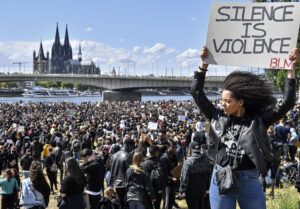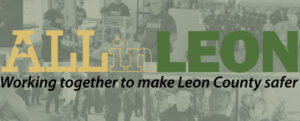
Since the murder of Trayvon Martin in 2012, communities in pursuit of justice have used protesting as a way to spread awareness and combat against an unjust justice system and police brutality. Recent protest activity has come about again in response to the deaths of George Floyd and Breonna Taylor. But how are communities moving past this?
In early September, The Leon County Sheriff, Walt McNeil, implemented a countywide curfew issued by the County Commission to help prevent further violence and civil unrest, but the violence that ensued was not caused by protesters lashing out but from their mere existence.
The protest was held as a reaction to the jury’s decision for the case of Tony McDade’s death, leaving no officer involved indicted. Within ten minutes of the protest, TPD arrived at the scene in Downtown Tallahassee suited in riot gear, that resulted in the arrests of 14 protestors, who have now been named the #Tally14.
“The curfew was specifically put in place to silence us, especially following the ruling of Tony McDade…When we found out about the curfew, we then pushed for our protests to begin earlier in the day as opposed to later to maximize our time,” said Niyah Lewis, President of the United Activist Coalition.
The United Activist Coalition (UAC), focuses on the disenfranchisement of minority people and the abilities to help them in fronts like education, voter engagement, sexual assault education, and much more. After Ron DeSantis proposed the Combating Violence, Disorder and Looting and Law Enforcement Protection Act, Lewis and her organization took a step back from being on the front lines of protests here in Tallahassee because of the magnitude of consequences that could ensue. For instance, those who organized protests could be charged with a RICO Liability, which is what kingpins are charged with often.Lewis was concerned as an African American as well as a student leader for those within the organization as well as herself.
In the past the UAC has held a sit-down event with Leon CountySheriff, Walt McNeil and local black attorneys to gain perspective on the ways that citizens could better interact during encounters with law enforcement. Lewis described this event as ineffective because just like previous instances, law enforcement has a hard time understanding that change comes from within.
“Often times the conversations are a way to appease rather than a way to change, with that mentality there is no way that there will be a decrease in police brutality any time soon,” continued Lewis as she described the many efforts she took as an activist.
Lewis and the UAC have had face to face conversations with local lawyers and FBI agents but continue to receive lack of accountability and misunderstanding. But working with law enforcement is not completely out of the question for the UAC, just too soon to tell due to previous experiences.
For Devan Vilfrard and the FAMU Chapter of the NAACP, their experience with protesting as an organization and events are slightly different.
“As a national NAACP requirement, we would have to apply with nationals and thecity before we take part in any protest,” commented Vilfrard, President of the FAMU NAACP. More than likely the organization would not be able to participate as a chapter. So, in order to remain consistent within their community dealing with social justice, the FAMU NAACP partners with community organizations and community leaders to ensure that they continue to establish plans andsolutions for the surrounding community.
Meeting with men and women in high positions within law enforcement has opened up a forum for the FAMU NAACP and the UAC. In these meetings they made sure thatall voices were heard and moved with intent and demanded frequentmeetings to keep the pressure on leaders in the lawenforcement communities.
Since the shooting of Tony McDade, the City Commission called on the Inspector General to produce a scope and objectives on the Tallahassee Police Department’s (TPD) use of force policy, General Order 60 and Response to Resistance.
Nearly 300 armed police officers displayed excessive force toward the peaceful protestors, only a week shy of a Tallahassee man pulling a gun on protesters during a march for solidarity with Kenosha. That gunman incident resulted in arrest and a quick release, free of all charges allowing him to use the Florida Stand Your Ground Law as his defense.
The audit was used to determine if the policy portrays the best practices of law enforcement for the current society. It was accompanied with an evaluation of officer training to analyze the fairness, appropriation, efficiency and prove to fit the time period with accurate changes within modern policing standards. The audit will be completed by the end of the year.
The Movement 850, has created a TPD Reform Petition due to high influx of calls from the summer to defund the police. These reactions came soon after the controversial shooting of Tony McDade. Though the city is forming a Citizens Police Review Board (CPRB) there have been mixed emotions toward the idea.
The CPRB will serve as an advisory board to the City Commission, City Manager and Police Chief. Members of this board review and discuss recommendations regarding internal affair reports involving use of force and other important interests to the CPRB, the Police Chief and the City.
In Leon county, the Leon County Sheriff’s Office has created a comprehensive plan called ‘All in Leon’ to make for a safer county.

“ALL in LEON” is a comprehensive plan to unify people, agencies, and organizations to work collaboratively to reduce crime in Leon County. It is a partnership which allows all stakeholders to work towards a common goal. “ALL in LEON” consists of four components: prevention, re-entry, enforcement, and community involvement. Each component seeks to use reliable data to implement proven strategies.
The plan put forth by the Sheriff’s Office focuses on prevention, re-entry, community involvement, enforcement and community goals. After speaking with Deputy Shade McMillian, the community and media relations team were not able to relay statistical data because of department transitions.
The community involvement plan, also known as PEACEMAKERS, works with community organizations to build strong relationships of mutual trust between law enforcement and communities because they are critical to maintaining public safety and effective policing. Law enforcement relies on the cooperation of community members to provide information about crime in their neighborhoods, and to work with deputies to devise solutions to crime and disorder problems.
This plan models after the Chicago Cure Violence Model, designed to engage youth and mediate high-risk conflicts before they turn violent. Cure Violence stops the spread of violence in communities by using the methods and strategies associated with disease control – detecting and interrupting conflicts, identifying and treating the highest risk individuals and changing community norms.
Though the project started with the intent to improve global health, it is currently ranked number nine in the top500 NGOs in the world and has been replicated in more than 60 sites around the world. The Cure Violence Model had seen a 48 percent decrease in shootings during the first week of the program, Tallahassee Peacemakers group plans to direct 75 youth or young adults away from crime.
“The coolest thing we have going on is our ceasefire program, said public information officer Shade McMillain.
The ceasefire program is an initiative that was founded that included business partners in the community to help fund rewards for anyone that had information to possession of illegal firearms. This helps increase community engagement with the local business in Leon County.
Though some constituents may feel the need to work alongside police officers is a useless tactic others see it as a step in the right direction.
“We can all practice our first amendment right but the best way to make our firstamendment rights effective is by strategizing, organizing, and networking in orderto have thorough and effective attempts… rather than speaking their mind but having their opinions fall short due tonot properly ensuring that their demands and issues are met by the rightsupporters and decision-makers,” concluded Vilfrard.
He believes partnering with law enforcement has great potential for building a betterrelationship, understanding, and trust amongst the community. And along with social media constituents recognized that change does not happen overnight but this can be beneficial to their communities. This action provides insight to different points of view and can be productive in finding a common ground.